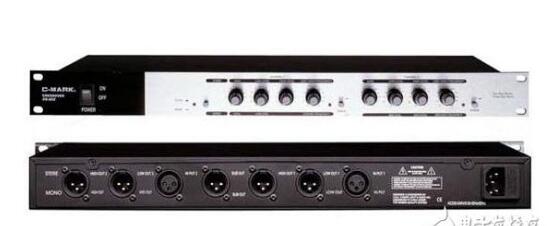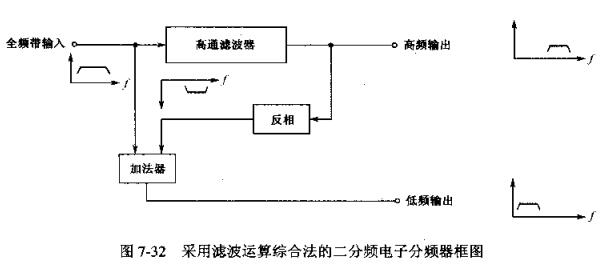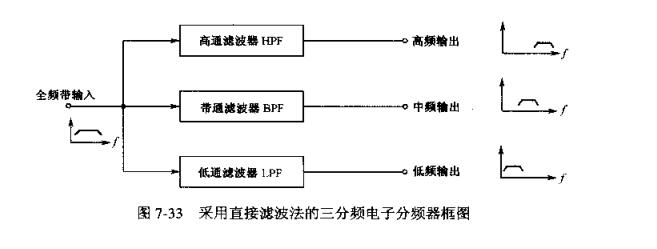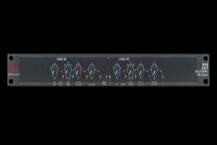In the sound system, the frequency divider is an important part of the normal and effective operation of the speaker, because the dynamic speaker in the process of increasing its sound power, due to its structural characteristics, resulting in narrower frequency coverage, in order to reach the full frequency range For high-power sound reproduction, loudspeakers must be produced in different frequency bands and then combined together to reproduce sound. Dividing the frequency is to split the signal into two or more frequency bands. It can make all loudspeakers in the loudspeaker system work in the optimal frequency range. In this way, the work efficiency of the amplifier is improved, the frequency distortion of the speaker is reduced, and the purpose of high-fidelity reproduction of the sound signal is achieved. According to the signal frequency band, the frequency band of the output signal can be divided into two frequency divisions, three frequency divisions and four points. Frequency, the circuit or audio device used to implement the frequency division task is called a frequency divider. According to the different position of the frequency divider, it can be divided into two kinds: power divider and electronic frequency divider. This article first introduced why to use electronic frequency divider, and then elaborated the working principle, role and characteristics of electronic frequency divider. Finally, the adjustment methods, precautions and development trends of the electronic crossover were introduced.

Our sound engineers study electroacoustics and now the development of electroacoustic equipment and technology are all for one purpose: to faithfully reproduce all kinds of sound sources, of course, to make the most varied use of natural sounds The reproduction of acoustic technology is almost impossible to achieve. As we all know, the frequency range of sound is between 20Hz and 20000Hz. Now the frequency range of most pre-stage audio processing equipment can reach such a width, but the current speaker has become a bottleneck, and we want to use one or more. It is very difficult for a few loudspeakers to transmit a wide frequency near 20Hz-20000Hz, because the effective operating frequency range of a single loudspeaker is not very wide. In view of this electro-acoustic engineers have designed speakers that work in different frequency bands, such as:
1. Subwoofer: Let it work in the frequency range of about 30-200Hz.
2. Low-midrange speaker: Let it work in the frequency range of about 200-2000Hz.
3. Tweeter: Let it work in the frequency range of about 2000-20000Hz.
In this way, we can use a variety of speakers working in different frequency bands to configure a sound system that can maximize the sound's real frequency (20Hz-20000Hz). Of course, the composition and parameters of different speaker devices are different. I said above is based on a three-way system. For example, there are other systems such as 2-frequency or 4-way frequency systems and they are used in different audio systems. Since the speakers used will be different, the operating frequency of these speakers may not be the same, but the general principles and ideas are the same.
So there is a question: How do we flexibly assign audio frequencies to these different types of speakers that work in different frequency bands? In order to solve this problem, an electronic crossover came into being, which can provide a suitable frequency band according to the needs of different speaker operating frequencies. For example:
1. We can use an electronic crossover to send high frequency signals through a power amplifier to a tweeter.
2. You can use an electronic crossover to send the IF signal through the amplifier to the midrange speaker.
3. An electronic crossover can be used to send the low-frequency signal through the amplifier to the subwoofer.
In this way, the high, medium and low-frequency signals are output independently and do not interfere with each other. Therefore, the advantages of the working frequency band of different speakers can be exerted as much as possible, so that the sound reproduction of each frequency band in the sound system becomes more balanced, so that the sound is more layered and the sound becomes more sound. perfect. This is why we use electronic dividers.

The electronic frequency divider uses various types of active filters (high-pass, low-pass, and bandpass) to divide the audio signal in the full frequency domain into different frequency bands. The active filter is composed of a passive RC filter network and an operational amplifier. The follower component consists of an attenuation characteristic that increases with the increase of the RC order (by increasing the first order, the attenuation slope increases by -6db/out).
The electronic frequency division method has only a power transmission line between the power amplifier and the speaker. There is no other link that affects the sound quality, which reduces distortion and improves the damping factor of the power amplifier to the speaker. Because the load of the electronic divider is the input of the power amplifier, the impedance is high and stable, so the crossover point can be easily adjusted. And controlling the frequency division accuracy, and because the bandwidth of each frequency band of the electronic frequency divider is narrow, the higher harmonic waves caused by nonlinear distortion are suppressed, and the total harmonic distortion and the intermodulation distortion are reduced, and the electronic frequency divider overcomes There are disadvantages in the power divider, but it increases the cost and the difficulty of system debugging, so it is mostly used in professional situations.
1ã€Schematic diagram of two-way frequency divider
Figure 7-32 shows a block diagram of a divide-by-two electronic divider using a filtering operation synthesis method. The basic principle is to use a set of high-pass or low-pass filters to filter out the signals of the corresponding frequency band, and then invert this signal. The full-screen input signal is summed to obtain another frequency band signal.

2. The working principle of the three-way frequency divider
The divide-by-three circuit uses a filter operation synthesis method. On the basis of the divide-by-two circuit, as long as the signals output by the high-pass and low-pass filters are all inverted and added to the full-band signals, an intermediate frequency output signal can be obtained.
Figure 7-33 shows a block diagram of a three-band electronic crossover using direct filtering. Its working principle is to input full-range signals into high-pass, band-pass, and low-pass filters, respectively, to obtain corresponding high, medium, and low-frequency signals.

1, the basic frequency task
Because there are many kinds of speakers nowadays, what kind of disease energy can be used in the system, and the frequency divider or the frequency divider of the electronic frequency divider must be flexibly configured. Nowadays, commonly used frequency multipliers have 2 frequency division, 3 frequency division, and 4 frequency division. In other cases, exceeding 4 divisions is too complicated and practical. Of course, today's electro-acoustic technology is changing with each passing day, and there are still some crossovers that can also perform audio and video signal processing in some other aspects. However, no matter what type of electronic crossover, the main functions and tasks are, of course, frequency division.
2, protect speaker equipment
We know that the operating frequencies of different speakers are different. In general, speakers with larger diameters have better low frequency characteristics and lower frequency dive. It is as if under the same conditions, the bass sound of 18-inch speakers will generally be better than the bass sound of 15-inch speakers; instead, the smaller-diameter speakers should be used in mid-range because the current cone vibration speaker caliber is usually used. The smaller the sound that is emitted, the higher the frequency; the diaphragm that pushes the treble section should also be very small in order to emit a high-frequency sound. Since speakers are so complex and so many types, it is important to ensure that they can work safely and effectively. The electronic crossover can provide the optimal operating frequency required by different speakers, allowing various speakers to work more rationally and safely. Imagine if the mid-high speakers in the system have not been frequency-divided by an electronic crossover, but have directly used full-range audio signals, these mid-range speakers will be easily damaged under the impact of low-frequency signals. In addition to the frequency division task, the normal use of its more important features are: to protect the speaker equipment.
3, increase the level of sound
If there is a lot of different kinds of speakers in a sound system, there is really no use of electronic crossover. Different types of speakers use full-frequency signals without frequency division. There will be a lot of frequency overlap and repeat between different speakers. In some cases, the sound interference will become very serious, the sound will become blurred, the sound field will be very poor and the microphone will be easy to produce acoustic feedback. If an electronic crossover is used to perform a reasonable frequency division, so that different speakers are in the best working condition, the frequency range of the sound emitted from different speakers will be almost not repeated, thus reducing the phenomenon that the sound waves interfere with each other. The sound will become clear and the tone will be better and more layered!
Electronic divider adjustment method1. MASTER-LEVEL: The adjustment of the channel signal input level is very important, just like the tuning of the mixer channel gain, the volume of the first step is critical. The general adjustment is more appropriate at a position similar to the 12 o'clock position and does not require major adjustments.
2. LOW-LEVEL: The adjustment of bass output volume depends on the crossover frequency and the number of subwoofers in the system. Generally, it is adjusted at 12 o'clock and 14 o'clock. When adjusting the same, also pay attention to see if the LOW-MUTE bass volume mute button is pressed, otherwise there will be no bass signal sent out.
3, LOW-MUTE: bass volume mute button. Press this button to cut off the volume of the LOW-LEVEL bass output. This is mainly for contrasting bass and treble effects, and of course do not press it during normal use.
4, LOW-DELAY: The bass delay knob adjustment to be flexible, according to the site effect to adjust, sometimes bass is too hard, too thin, we can open it, let the bass add a little delay, so you can increase bass integration Degree and fullness; on the other hand, if you feel that the bass is suitable, do not open it, otherwise the bass will appear cloudy and muddy. It is generally adjusted to be similar to clocks 8 o'clock and 11 o'clock.
5, LOW/HIGH-FREQUENCY: crossover knob. Adjusting the crossover frequency of the electronic crossover depends on the type and characteristics of the speaker used in the audio system. In the 2-frequency operation mode, it is usually adjusted within the range of 180Hz-250Hz. That is to adjust the position at 10 o'clock and 11 o'clock like clocks.
6. HIGH-LEVEL: Volume adjustment knob for treble output. The adjustment of the treble output volume depends on the crossover point and the number of mid-high speakers in the system. Generally, it is adjusted to the positions of 12 o'clock and 14 o' clock. At the same time, it is also necessary to pay attention to the degree of integration of the treble and bass. If the treble is too small, the surround sound of the bass will appear dim; if the treble is too large and too prominent, it will appear to be out of touch with the bass, and not merge. Moderately good.

1, crossover points: If in a 2-way audio system, the adjustment of the crossover point does not actually depend on the subwoofer, but rather on the midrange speakers. Because subwoofer can work under 300Hz, but some mid-high speakers because the speaker diameter is too small, the dynamic range is not enough, must work above 200Hz to ensure their safety, if the frequency points are divided at 130Hz, then these The tenor speakers work very dangerous.
2, the volume control: whether it is the input level or output level, there must be a degree of adjustment, do not open too much. If each volume knob on the electronic divider is open to a large volume and the sound pressure of the system is not enough, it is necessary to adjust the level of the signal in front of the electronic divider or to adjust the level and volume of the amplifier below the electronic divider. Attenuation switch. This must pay special attention, otherwise the signal in the electronic frequency divider is distorted and it is easy to damage the lower-level equipment.
3. There are some electronic crossovers with a: X10 button, we take care not to press it easily. For example, when our crossover point is adjusted at 200Hz, pressing this button 200X10 becomes 2000Hz, so unless you need it, you generally do not press this button.
4, some electronic crossover rear panel has a choice of bass mode, it can stereo 2 signal synthesis 1 output, this can reduce the sound interference between the low speaker. Everyone can use it properly. Of course, if the bass crossover points are higher, then the sound produced by the subwoofer will have a certain directionality, and at this time it is still better to work in the state of the 2 stereo signals.
5. Stereo mode and mono mode: At present, most of the electronic frequency dividers we use are mostly 2 frequency dividers. In view of flexibility and versatility, the rear panel of these electronic frequency dividers will generally have A stereo and monaural mode changeover switch. If this switch is placed in the mono mode, then this electronic crossover will change from a two-channel, 2-way electronic crossover. A single-channel divide-by-3 electronic divider was used. Therefore, unless you need to, do not easily switch this working switch, or else the frequency signal output from the signal output port behind the electronic crossover will be very different! The light deteriorates the sound quality, and the severer one will damage the equipment!
6. The output of the bass signal in the system and the output of the mid-high signal must not be confused. Otherwise, the treble signal gives the bass speaker and the bass signal to the treble speaker. In this way, there is no sound coming out from the audio system. Because the frequency is wrong! If you can't do it, you will burn the speakers!
7. Whether the main speakers are frequency-divided: The main speakers mentioned above are not going through the electronic crossover. Everyone should have their own opinions. When they do not understand it, they can compare and test several times before deciding. Do not make blind decisions.
8. When using a digital processor to divide the frequency, be sure to distinguish which is the crossover point and which is the operating frequency range. In addition, there will be a choice of frequency attenuation strength at the starting and ending points of the operating frequency range, such as 6dB, 12 dB, 24 dB, 48 dB, and several choices. We must use it flexibly, and it is generally appropriate to use 24 dB. .

Although we currently use a frequency divider called an electronic crossover, it is not digital after all. Its internal circuit is still analog and the accuracy of adjustment is not very accurate. In recent years, a number of digital processors have recently been introduced. These digital processors basically have a function of frequency division. At the same time, the frequency of the frequency division is displayed in digital form. At a glance, one can see clearly and the accuracy of the frequency division is The signal-to-noise ratio of the sum signal is greatly increased. What's more important is that these digital crossover methods are different from the previous electronic crossover. We use the dbx 260 digital speaker processor as an example for comparison. If we need to build a four-way high-end audio system, we need to build a 2-way system. After the standard full audio signal is input to the dbx 260 digital speaker processor, we can divide it into four bands to provide work for different speakers:
1. The 1st channel of dbx 260 digital speaker processor output signal is used for the subwoofer. The working frequency range is set at 30Hz-150Hz, and the frequency division point is set at about 90Hz.
2, dbx 260 digital speaker processor output signal provided to the subwoofer 2 to use, set the frequency range of the work frequency in the 130Hz-450Hz, frequency is set at about 220Hz.
3. The 3rd and 4th channels of the dbx 260 digital speaker processor output signal are provided for the low-midrange speaker. The frequency range of the working frequency is set at 400Hz-800Hz, and the crossover frequency is set at about 500Hz.
4, dbx 260 digital speaker processor output signal 5th, 6th channel for the use of high pitchers, set the frequency range of the work in the 750Hz - 20000Hz, frequency is set at about 2000Hz.
We can find that using digital processing can set an optimal operating frequency range after setting a crossover point. Such an accurate frequency division is impossible to do with the analog circuit in the electronic crossover anyway. Of course, in the above example, the operating frequency range and crossover frequency are not fixed, and fine adjustments should be made according to the sound box and sound field. However, through the above examples, we should understand that the digital age of professional audio will come sooner or later. As our sound engineer, we must constantly learn and master the latest electro-acoustic technology.
Ring Type Connecting Terminals
Ring Type Connecting Terminals,Terminals,Connecting Terminals
Taixing Longyi Terminals Co.,Ltd. , https://www.longyicopperlugs.com